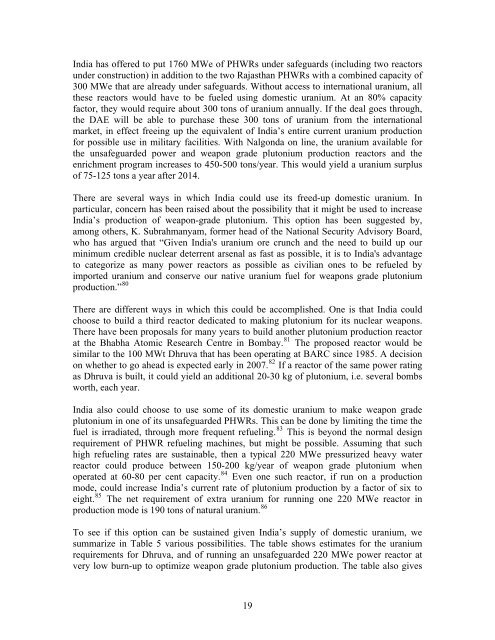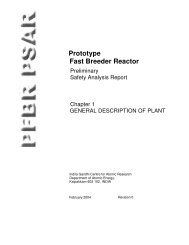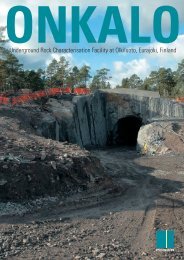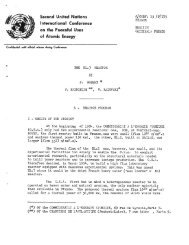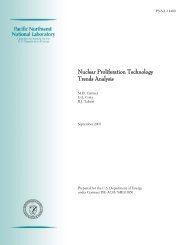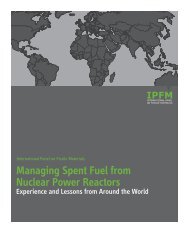Research Report No - International Panel on Fissile Materials
Research Report No - International Panel on Fissile Materials
Research Report No - International Panel on Fissile Materials
You also want an ePaper? Increase the reach of your titles
YUMPU automatically turns print PDFs into web optimized ePapers that Google loves.
India has offered to put 1760 MWe of PHWRs under safeguards (including two reactors<br />
under c<strong>on</strong>structi<strong>on</strong>) in additi<strong>on</strong> to the two Rajasthan PHWRs with a combined capacity of<br />
300 MWe that are already under safeguards. Without access to internati<strong>on</strong>al uranium, all<br />
these reactors would have to be fueled using domestic uranium. At an 80% capacity<br />
factor, they would require about 300 t<strong>on</strong>s of uranium annually. If the deal goes through,<br />
the DAE will be able to purchase these 300 t<strong>on</strong>s of uranium from the internati<strong>on</strong>al<br />
market, in effect freeing up the equivalent of India’s entire current uranium producti<strong>on</strong><br />
for possible use in military facilities. With Nalg<strong>on</strong>da <strong>on</strong> line, the uranium available for<br />
the unsafeguarded power and weap<strong>on</strong> grade plut<strong>on</strong>ium producti<strong>on</strong> reactors and the<br />
enrichment program increases to 450-500 t<strong>on</strong>s/year. This would yield a uranium surplus<br />
of 75-125 t<strong>on</strong>s a year after 2014.<br />
There are several ways in which India could use its freed-up domestic uranium. In<br />
particular, c<strong>on</strong>cern has been raised about the possibility that it might be used to increase<br />
India’s producti<strong>on</strong> of weap<strong>on</strong>-grade plut<strong>on</strong>ium. This opti<strong>on</strong> has been suggested by,<br />
am<strong>on</strong>g others, K. Subrahmanyam, former head of the Nati<strong>on</strong>al Security Advisory Board,<br />
who has argued that “Given India's uranium ore crunch and the need to build up our<br />
minimum credible nuclear deterrent arsenal as fast as possible, it is to India's advantage<br />
to categorize as many power reactors as possible as civilian <strong>on</strong>es to be refueled by<br />
imported uranium and c<strong>on</strong>serve our native uranium fuel for weap<strong>on</strong>s grade plut<strong>on</strong>ium<br />
producti<strong>on</strong>.” 80<br />
There are different ways in which this could be accomplished. One is that India could<br />
choose to build a third reactor dedicated to making plut<strong>on</strong>ium for its nuclear weap<strong>on</strong>s.<br />
There have been proposals for many years to build another plut<strong>on</strong>ium producti<strong>on</strong> reactor<br />
at the Bhabha Atomic <str<strong>on</strong>g>Research</str<strong>on</strong>g> Centre in Bombay. 81 The proposed reactor would be<br />
similar to the 100 MWt Dhruva that has been operating at BARC since 1985. A decisi<strong>on</strong><br />
<strong>on</strong> whether to go ahead is expected early in 2007. 82 If a reactor of the same power rating<br />
as Dhruva is built, it could yield an additi<strong>on</strong>al 20-30 kg of plut<strong>on</strong>ium, i.e. several bombs<br />
worth, each year.<br />
India also could choose to use some of its domestic uranium to make weap<strong>on</strong> grade<br />
plut<strong>on</strong>ium in <strong>on</strong>e of its unsafeguarded PHWRs. This can be d<strong>on</strong>e by limiting the time the<br />
fuel is irradiated, through more frequent refueling. 83 This is bey<strong>on</strong>d the normal design<br />
requirement of PHWR refueling machines, but might be possible. Assuming that such<br />
high refueling rates are sustainable, then a typical 220 MWe pressurized heavy water<br />
reactor could produce between 150-200 kg/year of weap<strong>on</strong> grade plut<strong>on</strong>ium when<br />
operated at 60-80 per cent capacity. 84 Even <strong>on</strong>e such reactor, if run <strong>on</strong> a producti<strong>on</strong><br />
mode, could increase India’s current rate of plut<strong>on</strong>ium producti<strong>on</strong> by a factor of six to<br />
eight. 85 The net requirement of extra uranium for running <strong>on</strong>e 220 MWe reactor in<br />
producti<strong>on</strong> mode is 190 t<strong>on</strong>s of natural uranium. 86<br />
To see if this opti<strong>on</strong> can be sustained given India’s supply of domestic uranium, we<br />
summarize in Table 5 various possibilities. The table shows estimates for the uranium<br />
requirements for Dhruva, and of running an unsafeguarded 220 MWe power reactor at<br />
very low burn-up to optimize weap<strong>on</strong> grade plut<strong>on</strong>ium producti<strong>on</strong>. The table also gives<br />
19


